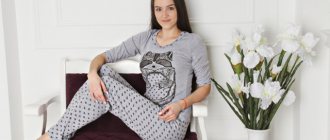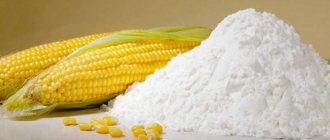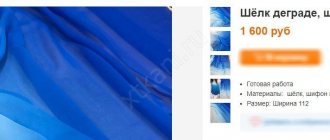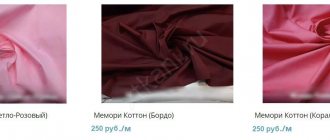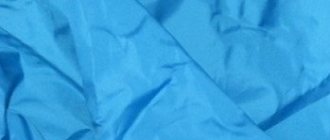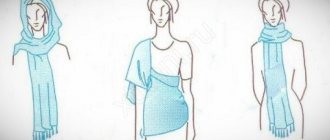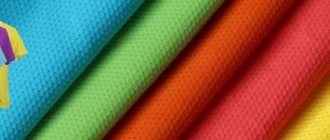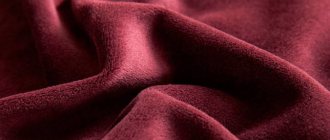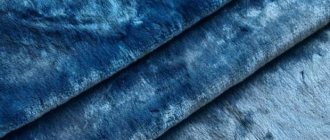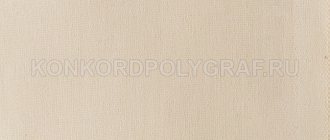Translated from French the word mélange
literally means “mixture” of: chemicals, foods, drinks and others. When applied to fabric, “melange” also means “mixture,” but of fibers of different colors, sometimes of different thicknesses.
Even if the word itself seems unfamiliar to you, you have already repeatedly encountered melange material: in things that look as if touched by ripples. For example, in Russia (and throughout the world) gray melange is very popular - men's T-shirts and sweaters, including uniform ones, are often made from it.
Threads of opposite, contrasting or similar colors can be woven together, each option gives its own effect. The composition may include not only exclusively cotton or exclusively synthetic fibers, but also mixtures: lavsan or nylon is often added to cotton to make the fabric stronger and brighter.
Also, threads of different thicknesses are often used in the manufacture of the material, due to which the fabric becomes more prominent and textured, although soft enough to be pleasant to the skin.
Melange includes variegated yarn - one that is immediately supplied in multi-colored yarn. From it, craftsmen knit clothes, accessories, toys and interior items in bright colors, with an effect that cannot be achieved by ordinary dyeing of the finished product.
Melange fabric - what is it?
Melange is a fabric that is created by combining fibers of different colors into a fabric.
They can be natural or artificial, twisted or simple, but always in different shades. Translated from French it means “mixing”, “stirring”. Initially, melange was obtained by weaving cotton or linen fibers. Since they were unprocessed, the resulting fabric was a combination of different shades of gray and beige in one fabric. It was noted that it is dense and also lasts a long time.
Then production was mechanized and they began to use not only raw cotton threads. Now melange is made:
- from wool, for example, angora;
- natural threads with the addition of synthetics - lavsan, viscose, elastane, nylon, nylon;
- waste from yarn production;
- flax;
- cotton;
- connecting fibers of different types to each other.
By using threads that are similar in tone, a characteristic melange color is obtained. For example, this is blue with blue, white with beige, red with crimson, etc. This is a gradient coloring - dark shades smoothly flow into light ones and vice versa. Because of this, things look somewhat voluminous, elegant and expensive.
Another production option is to use threads of different colors as a basis. For example, black and white, green and blue, yellow and red. The fabric can be woven from 2, 3, 4 multi-colored fibers. This method of staining is called contrast. The result is bright products that can improve your mood in cloudy weather.
To see what the fabric looks like:
How are these colors obtained?
Melange production technology does not provide for a single color designation.
Each factory has its own documentation to record the recipe and results of yarn dyeing. The composition and type of fibers, the mixture combination, and the formula for preparing the dye are also recorded. The finished melange fabric does not undergo bleaching, singeing or dyeing. Cleaning, cutting, napping, and mercerizing help to add decorative appeal, and treatment with adhesives increases strength and wear resistance.
The main directions in coloring are:
- Contrasting for obtaining variegated, rich canvases of mixed colors.
- Gradient, when threads of different colors of the same color are taken. The dark shade flows into the light one. For example, black to gray, brown to sand, and purple to lilac.
Minerals
| Contents per 100 g of product | Sodium, mg | Potassium, mg | Calcium, mg | Magnesium, mg | Phosphorus, mg | Iron, mg |
| Melange | 134,00 | 140,00 | 55,00 | 12,00 | 192,00 | 2,50 |
Related publications
- Grain exports from seaports increased by 25% - 10/09/2018
- Test tube meat is a real threat to the feed industry - 10/08/2018
- A new version of bird flu discovered in China - 09/28/2018
Next article
- How to choose the right chicken eggs: expert advice - 01/17/2017
Advantages and disadvantages of fabric
Advantages of melange material:
- abrasion resistant;
- wears for a long time;
- wide variety of colors.
Additives in fabrics impart various positive properties to fabrics:
- synthetic threads - elasticity, stretch, shine, durability;
- cotton – the ability to conduct air to the skin, lightness;
- Wool helps to retain heat and keep you warm.
Negative qualities of melange fabric:
- shrinks if made from natural fibers;
- stretches when the base is knitwear;
- deteriorates when exposed to hot temperatures;
- the presence of wool in the composition exposes the products to the risk of being damaged by moths;
- requires care.
See fabric review:
How to care for melange products?
Competent care and respect will ensure the durability and pristine appearance of any fabric. Basic rules for handling melange:
- It is recommended to wash products at a temperature not exceeding 40 degrees;
- the use of any type of chemical bleaches is unacceptable;
- products made from natural and synthetic fibers tolerate washing well in an automatic washing machine;
- for washing items made from sheep’s wool, use specially designed products and the “Wool” or “Delicate” mode;
- Do not dry melange items in direct sunlight, as this will cause them to quickly fade;
- It is recommended to iron products from the wrong side, choosing a temperature regime depending on the composition of the material.
How to make the right choice
So, you are ready to buy melange. You already understand what it is, now we will learn to make the right choice of a quality product. Pay attention to the elasticity of the thread, its strength, twist, and uniformity of coloring. If the thread is too twisted, it will not be suitable for knitting. It is designed for crocheting. Also, the finished product may turn out to be skewed, and no amount of ironing will save it.
The elasticity of the thread is checked quite simply: pull it, if it springs, then you have a quality product in your hands. It is very important that the melange thread does not have thickenings. Read the label carefully. It must indicate the percentage of different fibers, the length and weight of the thread, recommendations for choosing knitting needles and knitting density. These recommendations should not be ignored; they are given by experienced specialists from manufacturers based on numerous tests. Knitting melange is a fun and interesting activity.
What to do with purple?
Purple is a mixture of red and blue, two opposites, elements. However, purple is unique for its calming effect on the human psyche, its harmonious and attractive appearance.
This color is good for women, especially creative, pregnant, romantic, young and mysterious women.
Clothing in purple colors goes well with:
- yellow;
- orange;
- white;
- with lighter or darker shades of the same purple in one look.
For a meeting it is good to match purple with black, and for a romantic walk – with white.
For fair-haired or fair-haired girls, lilac, lilac, the color of grapes or ripe plums will look especially touching, and if you are a brunette, then an almost inky color, rich blueberry, thick indigo color will look good.
To avoid overdoing purple, don't pair it with red or green.
↑ return to table
Pastel shades and gray melange
In this case, melange acts as a background against which any pastel color scheme will look harmonious. Dark melange will perfectly complement those colors that are considered cold - pale pink (the most successful combination), soft blue, mint, lilac.
Light gray melange looks great in combination with pink, pale yellow, peach, and light green.
You can combine absolutely everything with gray melange. You can combine it with red, yellow, pink, green. The main thing is to make sure that the shades look harmonious on you. This is a great option for meeting with your loved one or going out with friends. Melange goes well with jeans.
Application and care
Comfortable and practical melange is perfect for creating casual street style clothing. Comfortable coats and suits, dresses and trousers are made from it, various accessories are made, and used as furniture upholstery.
Caring for such fabrics is not difficult, but it has its own characteristics and directly depends on the fibers that make up the fabric.
- Hand and machine washable in warm water.
- Products should be ironed from the inside out in a mode corresponding to those fibers that melt more easily.
- Dry in places protected from direct sunlight.
Melange fabrics are not only comfortable and practical, but also incredibly beautiful. Clothes made from this fabric can decorate the wardrobe of the most discerning fashionista.
To learn how to dye threads at home, watch the video.
In French, the word "melange" refers to a mixture of different ingredients. This term is used in the food and confectionery industries, as well as in the production of yarn and fabrics. Melange yarn is well known to needlewomen, and variegated fabrics are widely used for making clothing and household items and never go out of fashion.
How melange is used in clothing
Different types of materials are used to make clothes:
- Drap. Wool textiles made of two or more colors that retain warmth. Thanks to the special structure, there are no gaps between the closely knit threads. Used for sewing coats for the demi-season or winter period.
- Cloth. A subtle variation of the first, reminiscent of felt. Used to create suits for men.
- Cheviot. Smooth woolen or mixed fabric, also containing admixtures of cotton threads. Trousers, jackets and uniforms are made from Cheviot fabrics.
- Tights.
- Covercoat - characterized by a rib. Thanks to its unusual style, it resembles tweed.
Synthetics in melange provide an extraordinary visual effect and texture of textiles. This application guarantees improved fabric characteristics:
- elasticity;
- no dents;
- strength;
- does not shrink after washing.
Melange in clothes
Melange fabric is used to create street style clothing: T-shirts, pants, bikers, T-shirts and shorts. However, despite its versatility, melange in clothing requires care:
- Wash by hand or machine in warm water.
- Ironing is allowed only from the inside out.
- Drying, protected from active sun.
- The use of bleach is prohibited.
Melange looks beautiful in sporty, casual and formal styles. It is just not recommended to use the material to create evening dresses.
Jacket
Melange
(from French melange - mixture)
1. the same as Melange yarn.
2. Same as melange fabric.
(Terminological dictionary of clothing. Orlenko L.V., 1996)
* * *
French - mixing different colored fibers in yarn; fabric made from this yarn.
(Encyclopedia of fashion. Andreeva R., 1997)
Source: Encyclopedia of Fashion and Clothing on Gufo.me
Meanings in other dictionaries
- MELANGE - MELANGE - in chemistry - a mixture of concentrated nitric and sulfuric acids with a volume ratio of approx. 9:1. Used in the production of sulfuric acid using the tower method. MELANGE (from French. Big encyclopedic dictionary
- melange - egg MELANGE (from the French melange - a mixture, egg mass, preserved by freezing. M. is made from standard fresh or refrigerator eggs received from farms, free from infectious diseases. Agricultural Dictionary
- melange - -a, m. special. 1. Yarn or fabric made from mixed fibrous materials of different nature or color. 2. Frozen egg mixture, which is a substitute for fresh eggs. [From French mélange - mixture] Small Academic Dictionary
- melange - melange I m. 1. Yarn or fabric made from mixed fibrous materials of different manufacture, quality, and coloring. 2. decomposition Products made from such yarn or fabric. II m. Frozen mixture of egg yolks and whites, used in catering establishments and in the confectionery industry. Explanatory Dictionary by Efremova
- melange - Melange/. Morphemic-spelling dictionary
- melange - MELANGE, a, m. (special). Yarn made from a mixture of fibers dyed in different colors. | adj. melange, oh, oh. Melange fabric. M. combine. Ozhegov's Explanatory Dictionary
- melange - Melange, melange, melange, melange, melange, melange, melange, melange, melange, melange, melange, melange Zaliznyak's Grammar Dictionary
- melange - I. MELANGE I a, m. mélange m. 1. Mixing fibers dyed in different colors in yarn; also fabric produced in different colors; also fabric made from such yarn. Melange yarn. Bike melange. Melange cloth. BAS-1. Cloth yarn, melange. Dictionary of Gallicisms of the Russian language
- melange - MELANGE -a; m. [from French. mélange - mixture] 1. Special. Yarn and fabric from fibrous materials of different nature or color. 2. Scrambled eggs from eggs beaten with salt and milk; omelette. Make a m. on pork. M. with sausage, ham, herbs. Kuznetsov's Explanatory Dictionary
- melange - (French melange - mixture). A mechanical mixture of egg whites and yolks, without maintaining their exact ratio, sometimes frozen and stored in briquettes. Culinary dictionary
- melange - spelling melange, -a, tv. -em Lopatin's Spelling Dictionary
- melange - noun, number of synonyms: 5 breccia 6 breed 278 yarn 23 mixture 89 fabric 474 Russian synonym dictionary
- Blog
- Jerzy Lec
- Contacts
- Terms of use
© 2005—2020 Gufo.me
Melange - what color is it
It is impossible to determine what color melange it is. In reality, such a tone does not exist at all. This term refers to melange yarn consisting of multi-colored fibers.
Blue melange
Thus, melange is a woven fabric that is formed by using single-strand or twisted yarn from fibers (threads) that differ in color. The shade of the raw material can be contrasting or vary in tone.
The finished result is a fabric with a specific pattern that resembles polished marble tiles. The higher the contrast of the fibrous elements, the more expressive the textile becomes. Depending on this, two main types are distinguished:
- "Grainy". Up close it looks colorful, but from a distance it takes on one shade.
- "Gradient". All tones of the same color smoothly transition into one another.
Melange burgundy
Each company produces melange fabric using different technologies and methods, and color combinations also differ.
Gray melange and other colors
Gray melange is the most popular type of fabric. The more common option is with dark accents.
This true classic has the following advantages:
- restraint;
- a harmonious ensemble with all color spectrums.
The color gray melange looks beautiful with other shades, highlighting them favorably:
- apple and salmon, which creates a sensual and sweet composition;
- carmine and alizarin, adds some dramatic effect;
- orange, tangerine, powder - active sunlight is neutralized.
Attention! Gray melange material is used in clothing. All winter sweaters and sweatshirts from mass market stores are made from the described fibers.
Gray melange
Anthracite melange
Anthracite is a sophisticated color reminiscent of wet asphalt. It is used in clothing design, but still looks stylish in interior solutions.
Interior designers place emphasis on:
- warm colors with yellowness;
- gray pearls;
- shiny grey.
Interesting! Anthracite melange color sets off the bright elements in the room and presents all elements in a new favorable light.
Anthracite melange
Melange beige
Beige melange is most similar to skin color. Flesh color is divided into several spectrums, which are combined in their own way with other shades.
Beige goes well with the following colors:
- royal pink, sunset pink, lilac, fuchsia and raspberry. Warm shades complement and create a pastel cozy color scheme, cool shades create a warm-cold contrast;
- scarlet, coral red, ruby, wine and burgundy. This ensemble celebrates red as a new color and ignites the fire;
- peach, coral, golden, copper and red;
- pale yellow, sunny, banana, saffron and gold;
- warm and cool greens (pistachio, chartreuse, olive, khaki, emerald and malachite).
For your information! Beige also pairs spectacularly with blue and purple tones, creating a clashing ensemble.
Peach melange
Blue melange
Blue melange is a very original combination of aristocracy and practicality. Depending on the color pairs, the blue palette takes on a new light:
- to create thermal contrast, peach, soft pink, scarlet, Chinese red, wine, red zirconium and roses, mango, apricot, and curry are used;
- a cool, harmonious combination of blue looks impressive with apple green, pine, neon green, malachite and pale menthol.
Purple melange
A harmonious combination with a neutral palette always looks advantageous.
Application in the interior
Melange can look different every time. Its external parameters change dramatically depending on the incidence of sunlight and viewing distance. Even shiny fabric with sequins or lurex cannot boast of such an effect.
The surface of melange textiles is characterized by the presence of tubercles and irregularities. The described property adds an additional decorative effect. The delicate and soft fabric looks fleecy to the touch, which is why it is used in the interior.
The melange textile group is developed based on the following materials:
- cotton;
- flax;
- synthetic fibers.
Melange fabric in the interior
Due to its high wear resistance, melange fabric is used in the production of upholstery for upholstered furniture, rugs, covers for armchairs or sofas. Light and dark yarns are used to complement certain styles of interiors. These include:
- antique style. Used to create tapestries, runners in wine colors and matching furniture upholstery;
- Bauhaus. Melange covers with a gradient color in a neutral color combination;
- Biedermeier;
- boho. Variegated fabric is used to create bright splashes;
- avant-garde - a new look at practicality;
- Gzhel - blue palette paired with cool tones;
- grunge Natural melange without synthetic fibers, etc.
The use of melange is not only a practical move, but also an excellent statement of design solutions.
Melange pillows
Fashionable palette London autumn-winter 2020-2021
Now let’s take a quick look at London’s fashion palette.
As you can see, the shades Samba, Military Olive, Ultramarine Green and Sleet coincide with the New York palette. There are even more shades that have different names, but are very similar visually: Exuberance is an analogue of Amberglow, True Blue has something in common with Classic Blue, Burnt Henna has something in common with Fired Brick, Tawny Birch has something in common with Sandstone, etc. And in general, both palettes turned out to be very close in spirit and mood.
To sum it up, even color trends show a completely new approach to fashion: from fast fashion (fast fashion) to more durable and sustainable options. So you can confidently adopt these color palettes, since these shades will serve you for more than one season.
Author: Ekaterina Malyarova Image maker, creator of image and style training, author of the website Glamurnenko.ru. Since 2007, over 500 clients have gone shopping with me. More than 5,000 people attended trainings and seminars on image and style.
Brown-purple hair color: a fashion trend?
Brown-purple hair looks incredibly impressive without being too flashy. They attract the eye with their expressiveness and some drama. The base of this shade is a universal and natural brown color, which can be of any tone - both cold and warm. The purple tint makes the usual brown-haired strands not boring and as deep as possible.
Advantages and disadvantages of shade
For those who doubt it, we list the biggest advantages of brown-violet hair color.
- Firstly, the shade looks creative and interesting, but not provocative, so it will suit even a strict dress code.
- Secondly, this coloring emphasizes and makes the eye color more expressive.
- Thirdly, purple tints add visual volume to the hair.
Now let's move on to the disadvantages of dyeing brown hair with a purple tint.
- This color highlights redness and uneven skin.
- A cool brownish-purple tint can add age - women over 50 should avoid this coloring.
The nutritional value
Vitamins
- A Vitamin A 0.25 mg
- PP Vitamin PP 0.2 mg
- Beta carotene 0.06 mg
- A (RE) Vitamin A (RE) 260 mcg
- B1 Vitamin B1 0.07 mg
- B2 Vitamin B2 0.44 mg
- B5 Vitamin B5 0.5 mg
- B6 Vitamin B6 0.4 mg
- B9 Vitamin B9 8 mcg
- B12 Vitamin B12 2 mcg
- E (TE) Vitamin E (TE) 0.6 mg
- H Vitamin H 3 mcg
- PP Vitamin PP (NE) 3.6 mg
- Choline 70 mg
Macronutrients
- Fe Iron 2.5 mg
- Zn Zinc 3 mg
- I Iodine 7 mcg
- Cu Copper 180 mg
- Mn Manganese 0.035 mg
- Cr Chromium 10 mcg
- F Fluorine 63 mcg
- Mo Molybdenum 12 mcg
- Co Cobalt 7 mcg
- Ni Nickel 10 mcg
- Sn Tin 75 µg
Famous workers
- Boytsova (Anfinogenova), Vera - awarded the Order of Lenin.
- Erofeeva, Anastasia Fedorovna - Hero of Socialist Labor. Delegate to the 25th Congress of the CPSU.
- Sokolova R.F. - Hero of Socialist Labor.
- Saraeva V.V. is a full holder of the Order of Labor Glory.
Five employees of the plant were awarded the title of Hero of the Soviet Union on the fronts of the Great Patriotic War:
- Shvetsov, Ivan Ivanovich
- Babanov, Ivan Dmitrievich
- Dubrovin, Mikhail Yakovlevich
- Stolyarov, Alexander Nikanorovich
- Sakharov, Pavel Ivanovich
( 2 ratings, average 5 out of 5 )
What is inconvenient about the original product?
Anyone who has bought eggs at least once in their life (and only very foolish children do not fall into this category) knows how easy it is to damage them and how difficult it is to bring them home intact. Moreover, they, unfortunately, are stored quite little. At night in the summer we turned off the lights - and the next morning we have an unpleasant smell in the refrigerator, as well as food that is completely unsuitable for cooking. And even if stored correctly, eggs may not be of very high quality, because they could have been transported under inappropriate conditions, as a result of which the white and yolk inside were mixed. You break an egg, and instead of the necessary contents, you get the same foul-smelling mass. That is why in production, where such (but fresh!) ingredients are needed in large quantities, they prefer to use egg melange or powder from the same material. Among other things, the use of both derivatives greatly reduces the cost of the industrial baking process, since their creation involves substandard ingredients—broken, small eggs that have lost their integrity or presentation.
What can you knit from melange
Melange yarn is in great demand among needlewomen. With it they can realize their most interesting ideas. Due to the play of colors, the shortcomings of the knitting itself are smoothed out. This yarn allows you to make beautiful patterns without much effort - the unique color combinations will do it themselves.
You might be interested in what suprem is: fabric features
Melange is always relevant for both female audiences and men's and children's audiences. It is used to knit: pullovers, sweaters, sweatshirts, vests, swimsuits, scarves, hats, bedspreads, toys, etc. If the brightest colors are often used in children's and women's clothes, then for men they mainly use black, gray and blue shades.
Knitters who have pets enjoy sewing costumes for them. Decorating your home space with knitted items (for example, rugs, rugs, pillows, tablet cases) is very popular.
Products made from melange yarn always look original.
Melange yarn
( 2 ratings, average 4.5 out of 5 )
Complex combinations with anthracite color
If you want to make a multi-faceted combination with this, consider the following example:
- with gold - a noble, lush combination that looks no worse than gold and black. A rich and modern evening atmosphere is always beneficial for maintaining a luxurious style. - with coffee - the shades flow into each other due to the low light contrast, but create a natural harmony, rich and mysterious. The pair has a slight thermal contrast.
The combination can be complemented with light gray-beige, golden chestnut and black.
Popular types
In the first years of production of melange fabric, coarse unprocessed cotton of various shades, which was called gray linen, or motley, was used as a raw material for its production. It was not very beautiful, but cheap and durable material. Later, raw linen began to be made from higher quality threads, after first cleaning and mercerizing the fibers. Cotton variegated fabric is still produced today.
In addition, the following types of wool melange textiles are produced.
- Drape melange. Dense and durable fabric used for making winter outerwear. It can be two-color or multi-color, smooth or fleecy.
- Melange cloth. Warm woolen material, thinner than drape. Used in the production of suits for everyday wear.
- Cheviot. The fabric consists of wool fibers, sometimes with a small admixture of cotton. The fabric is in demand when sewing skirts, trousers,...
- Tights. Material for sewing trousers and tracksuits.
- Covercott. The canvas is distinguished not only by its melange coloring, but also by its special pattern with a characteristic scar.
Fabrics with a mixed composition can be divided into a separate group. Adding a synthetic thread that differs in color and texture to the base creates not only a special color scheme, but also makes the surface of the fabric more prominent. In addition, combining synthetics with wool or cotton significantly improves the performance properties of the fabric: strength, wrinkle resistance, and lack of shrinkage.
Making tapestries
A tapestry is a type of decorative and applied art that is a one-sided lint-free carpet with a thoughtful storyline (composition), made by hand by cross-weaving thin threads, like hair.
Until the eighteenth century, fine art was created using wool, most of it from sheep. Animals were then required to be fed high-quality food to keep their fur soft. Nowadays they use melange with all their might, since the main requirement in tapestries is strength.
Large melange
Wool fibers are often combined with linen, silk, cotton threads, horsehair and garus. This combination made it possible to play with lightened and colored areas, creating a separate picture.
Answering the question of what color it is - melange, it is impossible to find a specific explanation. Melange is a material with a complex structure, in which not only different components are combined, but also the color range varies. Thanks to its many properties, textiles have found application in many areas: from creating designer clothes to home decoration.
